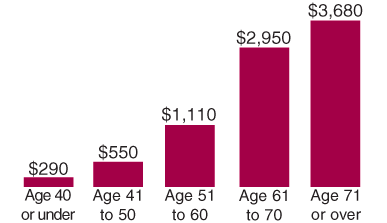 on. Please start collecting your income and deduction documentation for 2007 and review this issue of the Tax Update Newsletter for recent changes. Don't hesitate to call if you have questions or want to discuss your situation.
on. Please start collecting your income and deduction documentation for 2007 and review this issue of the Tax Update Newsletter for recent changes. Don't hesitate to call if you have questions or want to discuss your situation.
Tax Changes for 2007
In addition to the preprogrammed changes discussed and charted to the right, three federal tax laws passed in 2006 could result in substantially more tax savings when your 2007 tax return is filed. Here is a summary of some important changes for 2007 that apply to many clients:
Income Limits Up for Student Loan Interest Deduction. For 2007, up to $2,500 of interest you pay on qualified higher education loans may be deductible. The amount of the student loan interest deduction is phased out if your modified adjusted gross income (MAGI) is between $55,000 and $70,000 (between $110,000 and $140,000 if married filing jointly).
Income Limits Up for Hope and Lifetime Learning Credits. In 2007, the amount of your Hope ($1,650) or Lifetime Learning ($2,000) credit is phased out (gradually reduced) if your modified adjusted gross income (MAGI) is between $47,000 and $57,000 ($94,000 and $114,000 if you file a joint return). Married filing separately may not qualify for these credits.
Adoption Benefits Increased. The maximum adoption credit for 2007 has increased to $11,390. Also, the maximum exclusion from income for benefits under your employer's adoption assistance program has increased to $11,390. These amounts are phased out if your modified adjusted gross income is between $170,820 and $210,820. You cannot claim the credit or exclusion if your income is $210,820 or more.
Increase in Deductible Limit for Long-Term Care Premiums. For 2007, the maximum amount of qualified long-term care premiums you can include as medical expenses has increased. You can include qualified long-term care premiums as medical expenses, up to the amounts charted as here:
Long term Care Premium Deductibility

Note: The limit is for each person.
Mortgage Insurance Premiums. For 2007 you may deduct mortgage insurance premiums you pay during the year if they are related to taking out a new mortgage loan in 2007 to either finance or refinance the purchase of your home. The amount you can deduct is reduced by 10% for every $1,000 ($500 if your filing status is married filing separately) by which your adjusted gross income exceeds $100,000 ($50,000 if your filing status is married filing separately).
Return to TopKey 2007 Exemptions and Deductions
Listed here for your reference are key deduction rates for 2007.
Personal Exemptions -
The personal exemption for each qualifying dependent increases by $100 for 2007.
| 2007 | 2006 | |
|---|---|---|
| Exemption | $3,400 | $3,300 |
The exemption phases out by 2% for each $2,500 ($1,250 for married filing separately) by which your income is over:
| 2007 Phase Out | |
|---|---|
| Single | $156,400 |
| Married Filing Separately | $117,300 |
| Married Filing Jointly | $234,600 |
| Head of Household | $195,500 |
2007 Alert: This phaseout amount is now reduced by 1/3 in 2007.
Standard Deductions -
Standard deductions for those who do not itemize are as follows:| 2007 | 2006 | |
|---|---|---|
| Single | $5,350 | $5,150 |
| Married Filing Sep. | $5,350 | $5,150 |
| Married Filing Joint | $10,700 | $10,300 |
| Head of Household | $7,850 | $7,550 |
| If 65 or over and/or blind add: | ||
| Single/ Head of Household | $1,300 | $1,250 |
| Married/ Surviving Spouse |
$1,050 | $1,000 |
Itemized Deduction Phaseout -
Deductions are reduced by 3% of every dollar of Adjusted Gross Income (AGI) over $156,400 ($78,200 if married filing separately) up to a maximum phaseout of 80% of your itemized deductions. Your medical expenses, investment interest, casualty losses and gambling losses are excluded.
2007 Alert: The phaseout amount noted above is now reduced by 1/3 in 2007.
Standard Mileage Rates -
The standard mileage rates for 2007 are:| Mileage | 2007 Rate/Mile |
|---|---|
| Business Travel | 48.5¢ |
| Medical/Moving | 20.0¢ |
| Charitable Work | 14.0¢ |
2007 Tax Rates
The income brackets for each tax rate are:
| Single | Married Jointly | Head of Household | Tax Rate |
|---|---|---|---|
| $1-7,825 | $1-15,650 | $1-11,200 | 10% |
| $7,826-31,850 | $15,651-63,700 | $11,201-42,650 | 15% |
| $31,851-77,100 | $63,701-128,500 | $42,651-110,100 | 25% |
| $77,101-160,850 | $128,501-195,850 | $110,101-178,350 | 28% |
| $160,851-349,700 | $195,851-349,700 | $178,351-349,700 | 33% |
| Over $349,700 | Over $349,700 | Over $349,700 | 35% |
Charitable Receipts Reminder
 Remember to collect all receipts and proof of your charitable giving. New rules apply for 2007. When it comes to deductions for your charitable donations it is now important to practice:
Remember to collect all receipts and proof of your charitable giving. New rules apply for 2007. When it comes to deductions for your charitable donations it is now important to practice:
Less Cash. Try to replace cash contributions with payments by check or credit card to create a record.
Receipts. If you give cash, ask for receipts from the charitable organization.
Qualified Organizations. Always make sure the charitable organization is an IRS qualified charity. If in doubt, ask the charity.
Non-cash Giving. Non-cash donations of household goods and clothing must now be in good or better condition for deductibility. Take pictures of your donated items and list them individually, then attach these to the receipt received from the charity.
Vehicle Donation. If you donate a vehicle be sure you know what the charity will do with it. If they sell it without using it or fixing it you may only deduct the amount they receive for the vehicle. You may use the "fair market value" of your vehicle if the charity uses the vehicle to serve the charity's purpose or substantially improves the vehicle and then sells it.
Donate your IRA. If you are over 70 1/2 and have to make a minimum distribution from your IRA you may want to consider donating some or all of the distribution depending on your needs. For 2007, IRA distributions directly to a qualified charity are tax free and will not be counted as income on your return which may lower your taxes even more. You won't be able to deduct the contribution, however.
Mileage. Keep a log of any driving you do in connection with charitable and volunteer work. You can deduct either your actual expenses or 14¢ per mile plus parking and toll charges.
Return to TopMedical Expenses
High health care costs have taxpayers considering the itemized deduction for medical expenses with renewed interest. As you may know, the deduction is limited to the amount of all your unreimbursed medical expenses that, when combined, exceeds 7.5% of your adjusted gross income (AGI). For many individuals, surpassing the 7.5%-of-AGI floor is getting easier. Check the list below for some of the expenses you may be able to deduct.
- Health insurance premiums.
- Co-pays, deductibles, and other amounts paid out-of-pocket for hospital and nursing care, visits to doctors and dentists, and prescription medications.
- Medically necessary home improvements.
- Long-term care insurance premiums and services (within IRS limits).
- Transportation to receive medical treatment, as well as food and lodging en route.
Tip: Taxpayers with medical expenses close to the 7.5% AGI hurdle may want to see if they can accelerate or decelerate incurring medical expenses to "bunch" them into a single tax year for higher deductions.
Return to TopMaximize to Minimize
One of the best ways to minimize your income taxes is to maximize your pre-tax contributions to a retirement savings plan. The pre-tax contribution limits for 2007 are shown below. Try to maximize your contributions this year for the double benefit of lower income taxes and higher retirement savings balances.
2007 Retirement Savings Contribution Limits
| Plan Type | Under Age 50 | Age 50+ |
|---|---|---|
| 401(k) | $15,500 | $20,500 |
| 403(b) | $15,500 | $20,500 |
| SIMPLE | $10,500 | $13,000 |
| IRA | $4,000 | $5,000 |
E-Mail Scam Reminder
 The IRS DOES NOT INITIATE CONTACT VIA E-MAIL. This says it all.
The IRS DOES NOT INITIATE CONTACT VIA E-MAIL. This says it all.
Do not reply to any e-mail that comes from the IRS. The IRS has warned taxpayers of numerous e-mail scams that are currently being circulated. From receiving $80 for filling out an IRS e-mail survey to e-mails from the IRS "Fraud Department" to file an investigation report. All are cases were crooks are trying to get your confidential information.
Return to TopKiddie Tax Rule Changes
 In 2006, a child's investment income over $1,700 was subject to tax at the parent's higher rate if the child was under 18 years old (this age limit was under 14 years old prior to 2006).
In 2006, a child's investment income over $1,700 was subject to tax at the parent's higher rate if the child was under 18 years old (this age limit was under 14 years old prior to 2006).
Now in 2007, the rules are even stricter. The kiddie tax applies to children under the age of 19 OR under age 24 if the child is a dependent and a full-time student.
Return to Top